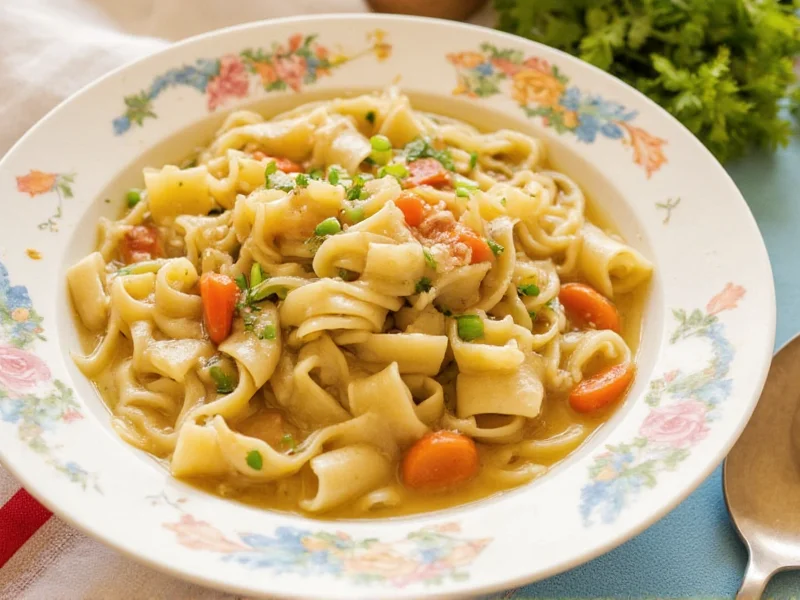Why Homemade Noodles Elevate Chicken Soup
While canned or dried noodles offer convenience, fresh homemade noodles transform ordinary chicken soup into something extraordinary. The secret lies in their delicate structure—unlike commercial noodles with stabilizers and preservatives, homemade versions lack excessive gluten development that causes toughness. When added to hot broth, they absorb flavors while maintaining a tender-yet-substantial bite that complements shredded chicken and vegetables.
Professional chefs consistently choose fresh noodles for soup applications because they cook faster and integrate seamlessly with broth. The egg content in traditional recipes creates a subtle richness that balances the soup's savory notes. Most importantly, you control every ingredient—no mysterious additives or excessive sodium that often plague store-bought options.
Essential Ingredients for Perfect Soup Noodles
The magic of easy homemade noodles for chicken soup comes from ingredient simplicity. All-purpose flour provides the ideal protein balance—bread flour makes noodles too chewy for soup, while cake flour lacks structure. Eggs contribute richness and help bind the dough without excessive water that weakens gluten.
| Ingredient | Function | Substitution Options |
|---|---|---|
| All-purpose flour | Creates tender yet stable structure | 75% all-purpose + 25% semolina for heartier texture |
| Large eggs | Binds dough, adds richness | 3 tablespoons water + 1 teaspoon oil for eggless version |
| Salt | Strengthens gluten, enhances flavor | None needed if adding to seasoned broth |
| Water | Adjusts dough consistency | Chilled broth for flavor infusion |
Step-by-Step Noodle Preparation
Creating simple chicken soup noodle recipe from scratch requires no special equipment. Start by mounding flour on a clean surface with salt in the center. Make a well and add beaten eggs. Using a fork, gradually incorporate flour from the edges until a shaggy dough forms. Knead gently for 3-4 minutes until smooth—overworking creates tough noodles.
Wrap the dough in plastic and rest for 30 minutes. This crucial step relaxes gluten, making rolling easier. Divide into 4 portions. On a floured surface, roll each portion to 1/16-inch thickness—thinner than pasta for soup applications. Let the sheet dry for 5 minutes, then cut into 1/4-inch strips using a sharp knife or pizza cutter.
Cooking Noodles Directly in Soup
For best noodles to add to homemade chicken soup, skip boiling separately. Add cut noodles directly to gently simmering broth. Stir immediately to prevent sticking. Cook uncovered for 8-10 minutes—fresh noodles cook much faster than dried. The broth should maintain a gentle bubble; vigorous boiling breaks delicate noodles.
Timing matters: add noodles during the last 10 minutes of soup preparation. This prevents overcooking while allowing flavors to meld. For meal prep, cook noodles separately, rinse in cold water, toss with少许 oil, and refrigerate for up to 2 days. Add to reheated soup just before serving.
Troubleshooting Common Noodle Problems
Dough too dry? Sprinkle water sparingly—1 teaspoon at a time. Too sticky? Dust with flour but avoid adding excess, which makes noodles tough. If noodles stick after cutting, separate strands with additional flour before adding to soup.
Prevent mushiness by avoiding these mistakes:
- Adding noodles to boiling broth (gentle simmer only)
- Cooking longer than 10 minutes
- Stirring too vigorously during cooking
- Adding noodles to soup that's already fully cooked
Flavor Variations for Special Occasions
Enhance your traditional chicken soup noodle recipe with simple additions. Mix 1 tablespoon finely chopped fresh dill or parsley into the dough for herbal notes. For golden noodles, replace one egg with an extra yolk. Whole wheat enthusiasts can substitute 25% of the flour with white whole wheat for nutty flavor without compromising texture.
When serving to guests, cut noodles into elegant ribbons or use cookie cutters for playful shapes kids love. For Jewish penicillin authenticity, make wide, flat lokshen noodles following the same basic technique with slightly thicker rolling.
Storage and Reheating Tips
Uncooked noodle dough keeps refrigerated for 24 hours or frozen for 1 month. Portion dough before freezing for quick soup preparation. Cooked noodles maintain best texture when stored separately from broth—combine only when serving.
Revive leftovers by heating broth first, then adding noodles. This prevents the sogginess that occurs when reheating complete soup. For frozen portions, thaw overnight in refrigerator before reheating.
Frequently Asked Questions
Can I make these easy homemade noodles without eggs?
Yes, create eggless noodles by replacing eggs with 6 tablespoons water and 1 teaspoon olive oil. The texture will be slightly less rich but still excellent for soup applications. For vegan versions, use aquafaba (chickpea brine) which provides similar binding properties.
How do I prevent homemade noodles from dissolving in soup?
To maintain noodle integrity, ensure your dough has proper hydration (should feel like firm Play-Doh), roll to consistent 1/16-inch thickness, and add to gently simmering (not boiling) broth. Cook uncovered for exactly 8-10 minutes—fresh noodles cook much faster than dried varieties and overcooking causes disintegration.
What's the ideal noodle thickness for chicken soup?
For perfect how to make soup noodles without a pasta maker results, roll dough to 1/16-inch thickness—about two stacked quarters. Thicker noodles won't cook through properly in the short soup time, while thinner versions become too delicate. Test by cooking one noodle first to check texture before adding the entire batch.
Can I prepare these noodles ahead of time?
Absolutely. Cut noodles can be tossed with flour and refrigerated for 24 hours before cooking. For longer storage, freeze cut portions on a baking sheet, then transfer to airtight containers for up to 2 months. Cook frozen noodles directly in soup—add 1-2 minutes to cooking time. Never store uncooked noodles with broth, as moisture causes sogginess.
Why do my homemade noodles turn out tough?
Tough noodles usually result from over-kneading (limit to 4 minutes), insufficient resting time (minimum 30 minutes), or excessive flour during rolling. High-protein flours like bread flour also create chewiness inappropriate for soup. For tender results, use all-purpose flour, handle dough minimally, and always allow proper resting time before rolling.











 浙公网安备
33010002000092号
浙公网安备
33010002000092号 浙B2-20120091-4
浙B2-20120091-4